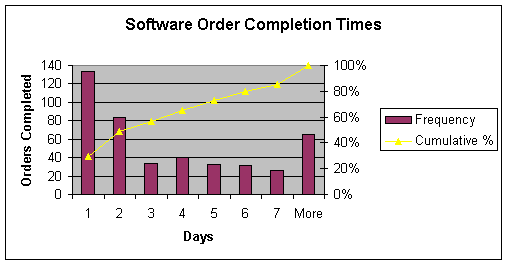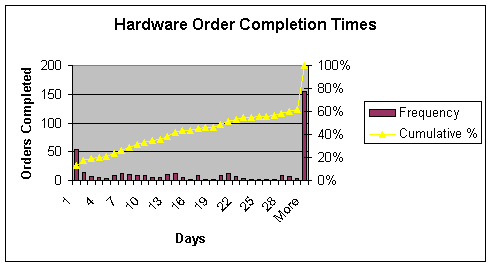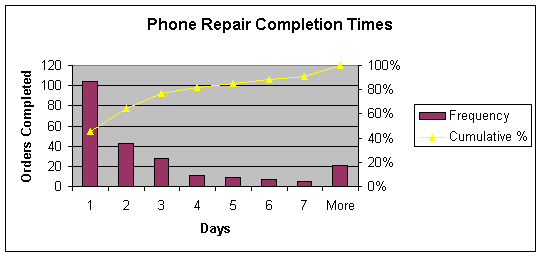
|
Contractor |
DOE Office |
|
Contract No.: DE-AC03-76SF00515 |
LCMD Name: Charles Boes |
|
Point of Contact: Brenda Eberle |
Telephone No.: (510) 637-1632 |
|
Telephone No.: (650) 926-2321 |
CO Name: Tyndal
Lindler |
|
E-mail: eberle@slac.stanford.edu |
Telephone No.: (650) 926-4963(SLAC) |
|
|
(510) 637-1885 (OAK) |
Date of last assessment:
October 1999
The telecommunications functional area received the
following ratings in the FY 1999 Annual Appraisal:
1.1.a.4 Video conferencing system
is meeting the community's needs - Outstanding
1.1.a.5 Emergency communications
system as defined on 4/3/96 is operating as specified and meeting customer's
needs (CSS and content analysis) - Outstanding
1.1.b.4 Phone orders are
processed in a timely fashion and meeting customer needs (CSS and order
analysis) - Outstanding
1.1.b.5 Phone repairs are
completed in a timely fashion and meeting customer needs (CSS and order
analysis) - Outstanding
Our self-assessment team
identified areas of opportunity for enhanced performance and will address those
areas in the following report.
There were no open items from the
1999 review.
Departmental Overview
The
Stanford Linear Accelerator Center (SLAC) is dedicated to experimental and
theoretical research in elementary particle physics and in those fields that
make use of its synchrotron radiation facilities, including biology, chemistry,
geology, material science and electrical engineering. This includes the
development of new techniques in particle acceleration and detection, and of
synchrotron radiation sources and associated instrumentation. The Center is
operated as a national user facility for the Department of Energy by Stanford
University.
Organizational Missions
The Telephone Services functional area manages telephone
services as a corporate resource to improve the quality of its services, to add
value to scientific programs and customer services, and as a tool to improve
work processes. Telephone service will be made available to the community,
the public, industrial partners, and others, as appropriate. The focus
this year was on reducing misuse of telecommunications services by improved
tracking of telephone locations; researching and analyzing options for a switch
replacement or contract re-negotiation; and reducing hardware order completion
times.
Names, titles, affiliations of participants
Les
Cottrell, Assistant Director,
SLAC Computing Services
Brenda
Eberle, Telecommunications
Analyst, SLAC Computing Services
Fred
Hooker, Network Operations
Supervisor, SLAC Computing Services
This report represents the
results of the telecommunications functional area self-assessment, an ongoing
process begun as part of the Business Management Oversight pilot established by
DOE in March 1995 and continued by executive order as part of DOE
performance-based management. Assessment material was collected over the
past year, followed by a process of validation of findings, analysis and report
writing. The telecommunications functional area self-assessment is based
on and measured against performance activities currently agreed to between SLAC
and DOE/OAK in order to address customer satisfaction, cost efficiency, and
contract compliance.
SLAC has a multi-year service
subcontract with Williams Communications to provide the majority of
telecommunications services including video conferencing and voice mail services
currently in use. The subcontract period began in July 1988 and will end
in February 2002. This service includes Williams' owned switching
equipment, the telephone cable plant and a dedicated technician. SLAC has
month-to-month agreements with other telecommunications service providers for
traffic carrier services, radio and paging services, and cellular phone service,
which are renewed on a fiscal year basis. These vendors include Pacific
Bell, for local calling and network access, ISDN and measured business lines;
STS, AT&T and FTS2000, for long distance calling; AirTouch, for wide area
paging service; Motorola, for mobile radio services; and CellularOne, for
cellular phone service.
The Williams-supplied telephone
system includes a 4,150-port digital electronic switching system and a cable
plant that is adequate to the system but is stretched and old. The cable plant
is based on twisted pair copper technology with surge protectors, both within
and between buildings. The switch is capable of supporting more advanced
and expensive digital technologies such as Integrated Services Digital Network
(ISDN). The system includes direct inward dial service, voice mail, government
and public network access, paging access and video conferencing. The
system supports a majority of mass-market, single-line instruments (3200 ports)
and some proprietary multi-line instruments (600 ports) to provide secretarial
type functions. The remaining 350 ports are used for trunks. The
system provides alarm circuits, emergency communications, and back up power
capability.
During the past year, we have
worked with users, the facilities group, and other individuals to complete an
inventory of telephone lines. We have verified the locations of over 99
percent of our existing lines. Telephone locations are now tracked through
the SLAC Institutional Database.
We have negotiated with Williams
to provide an upgrade that will bring our switch hardware and software to
current levels. The upgrade will also include hardware to support ISDN
PRI's for our local and FTS2001 traffic, and improvements to our system
management tools. This will be done at no additional cost to the contract.
SLAC pays for a majority of the
Williams-provided phone service on a guaranteed fixed price per line per month
basis for the life of the contract, with the exceptions of the voice mail and
video conferencing systems that SLAC owns. Carrier services are based on
current CPUC tariff and federal government rates and paging and radio services
using a negotiated rate structure.
The system is managed in
partnership with Telecommunications Staff and user representatives called Area
Telecommunications Office Motivators (ATOMs). ATOMs were appointed by
group leaders in 1987 to represent a group or geographical area of from 15-200
phones and/or users. They interface with the Telecommunications staff
using user-driven on-line tools developed by Telecommunications to activate
services and identify order status. Lead-times to complete requests for
changes are from one to four weeks, depending on type of request.
The activities of the
Telecommunications functional area include, but are not limited to, providing
wired and wireless telephone, radio, paging, and video conferencing services.
This year the areas of telephone services and emergency communications were
assessed
Discussion of Individual Performance Objectives
2000 Telephone Services Self-Assessment
Services: We were able to negotiate rates for local
toll calls that are slightly better than the rates we were getting for calls
over our foreign exchange lines serving San Francisco and the East Bay. As
a result, we disconnected a group of eight foreign exchange lines in February,
and are now routing that traffic through STS. Because our previous traffic
study showed that we were slightly over-trunked on our local route, we were able
to absorb the additional traffic and bring that group close to its target
utilization.
We have maintained eight tie lines to the Stanford Campus
for many years. These lines were lightly used and maintained primarily for
the convenience of our users. Because the equipment used for these
facilities was old and no longer maintainable, we worked with the identified
users of these lines to ensure that they could access Campus via local telephone
calls. We also worked with SLAC's Security department, who took over calls
to SLAC's main-listed number that were previously routed to the Campus
operators. The eight tie lines were disconnected in April.
We have obtained a traffic study through Williams
Communications to review our current requirements. At the time our PBX is
upgraded, we will replace our DID trunks and local outgoing trunks with four
ISDN PRI's. This will provide us with some additional economy of scale
with respect to the total number of trunks needed to support our traffic.
In addition, we will be able to provide our users calling party identification
on digital display phones.
Our transition of FTS2000 voice services to FTS2001 is
scheduled to coincide with the upgrade of our PBX. Bringing these services
directly into the PBX, rather than through the Teleos hub, will significantly
improve the reliability and serviceability of the connections.
Telephone Orders Meet Customer Needs: During the
1998 fiscal year, we replaced our previous telephone order system that ran on VM
with the new SLAC Phone Request System (SPRS), based on the commercial Remedy
application, with Web interfaces for users. During the past year we have
continued to make improvements to the system as needed. We have
transitioned to a largely paperless workflow for tracking orders within the
Telecommunications group. The new system was well received by the ATOMs
(Area Telecommunications Office Motivators), who submit orders for their
departments. And the ATOMs have reported that the system continues to
become easier to use as they gain more experience with it.
In addition to the objective data collected from the SLAC
Phone Request System, we used the services of a consultant from outside our
department to request anonymous feedback from the ATOMs through a short survey.
We requested responses to five questions, several of which were similar to
questions used in previous surveys. A long-standing question about the
usefulness of the SLAC Telephone User's Guide was replaced with a question about
the SPRS. This reflects the fact that the Web-based SPRS is now the
primary entry point for most ATOMs to access telephone information and services.
Twenty-four out of fifty-nine ATOMs chose to participate in the survey.
For analysis purposes, we divide the orders into two types:
software and hardware.
Our goal is to complete most software orders in one week or
less.
The following table shows selected measurements for
software orders.
|
Measurement |
Days |
|
Median |
2.01 |
|
80 Percentile |
5.91 |
|
85 Percentile |
6.28 |
|
90 Percentile |
9.09 |
The following graph shows the number of software orders
completed in a specific number of days and the cumulative percentage of orders
completed within that time period. Eighty-six percent of software orders
are completed within one week.

Our goal is to complete most hardware orders within one
month. Some orders can stay in the system for much longer for reasons that
are largely beyond our control. Examples include waiting for access to
tunnels and waiting for users to complete construction or install conduit.
In addition, we have a single technician available to handle both hardware
orders and repairs. Because repairs generally receive higher priority than
new orders, work on hardware orders can be delayed for several days while other
problems are resolved. For these reasons, we believe it is realistic to
expect hardware orders to take somewhat longer than other types.
The following table shows selected measurements for
hardware orders.
|
Measure |
Days |
|
Median |
20.87 |
|
80 Percentile |
45.24 |
|
85 Percentile |
56.06 |
|
90 Percentile |
62.89 |
The following graph shows the number of hardware orders
completed in a specific number of days and the cumulative percentage of orders
completed within that time period. Sixty-one percent of hardware
orders are completed within thirty days.

ATOMs were asked to indicate whether they agreed with the
statement "Software orders are completed in a reasonable length of
time." They were given a five-point scale (strongly disagree,
disagree, acceptable, agree, and strongly agree). One hundred percent of
ATOMs rated performance as acceptable or better. In 1999, ninety-four
percent of ATOMS rated performance as acceptable or better.
ATOMs were also asked to indicate whether they agreed with
the statement "Hardware orders are completed in a reasonable length of
time." Seventy-eight percent of ATOMs rated performance as acceptable
or better. In 1999, seventy-six percent of ATOMs rated performance as
acceptable or better.
In 1998, ATOMs were asked to respond to a single statement
"Orders are completed in a reasonable length of time." Sixty
percent of ATOMs rated performance as acceptable or better. So we have
continued to show improvement in user satisfaction with order timeliness.
We have taken several actions to reduce the time required
to complete hardware orders. We have made improvements to the reports used
to track performance on orders. We have added automated reminders to alert
the person an order is assigned to, if they have not updated the order within
the past seven days. We have also performed weekly order analysis and
prioritization for hardware orders that are open in excess of fourteen days.
Performance in this area has been gradually improving over the last several
months and we expect to see continued improvement during the coming year.
Telephone Repairs Meet Customer Needs: Any person
at SLAC can request a telephone repair either by using a Web-based form in the
SLAC Phone Request System (SPRS) described above, or by leaving a voice message
on the phone repair line. In the past, the data collected from both of
these sources was accumulated to compute statistics on time to order completion.
This year we have collected data only from the Phone Request System. Based
on previous experience, we know that repairs reported through the SPRS tend to
be more complex and take slightly longer to complete than those reported through
the telephone repair line.
Due to the difficulties involved in obtaining a
representative sample of all telephone users at SLAC, we relied upon the ATOMs
to provide subjective feedback on behalf of all their users through the survey
described above.
The data collected indicate that over forty-six percent of
repairs are completed in one day or less. The chart below shows the
frequency and cumulative percent of repairs completed in a given number of days.

ATOMs were asked to indicate whether they agreed with the
statement "Repairs are completed in a timely fashion." They were
given a five-point scale (strongly disagree, disagree, acceptable, agree, and
strongly agree). Ninety-two percent of the ATOMs rated performance as
acceptable or better, compared to eighty-two percent in the 1999 survey, and
sixty-eight percent in the 1998 survey.
2000 Emergency Communications Self-Assessment
It is the responsibility of each
person in the emergency organization to determine what communications resources
they need to fulfill their responsibilities. Beyond the role of the
Emergency Communications Manager in restoring telecommunications services and
allocating alternate resources in an actual emergency, we provide services to
the emergency organization in the same manner as we do to other users.
That is we help users to clarify their actual communications needs, provide
information about available alternatives, provide services where appropriate,
and refer users to other resources for products and services we do not provide.
During the past year, tests of the emergency communications
systems were conducted ten times. SLAC’s Emergency Coordinator indicated that
his primary concern in regards to the emergency communications tests is to test
the wireless systems on a regular basis. The responsibility for running these
tests has been taken over by SLAC’s wireless communications analyst. Following
each test, users verbally communicate the quality of the tests results to the
wireless analyst. If there were any portable/base station/mobile unit problems,
the wireless analyst would have completed the necessary repairs. No problems
with emergency wireless equipment were reported.
In addition, during the past year, preventive maintenance
was done twice on all emergency wireless equipment. The wireless analyst
conducted tests to ensure each emergency wireless portable/base station/mobile
transmit frequency, output power level, and receiver sensitivity were within
specification. During preventive maintenance, the wireless analyst found that
one base station transmit output power level did not meet specifications.
This was repaired.
The Emergency Coordinator indicated the current emergency communications system continues to meet the user's needs. There is also support for continuing the wireless tests and preventative maintenance. We plan to continue support for the wireless tests and preventative maintenance for this area.
Contract compliance:
Our assessment team found the
telecommunications functional area to be in compliance with laws, regulations
and, terms and conditions of the current DOE contract. The
telecommunications functional area assessment team found no fraud, waste, or
abuse issues.
Work
with Williams to perform physical remediation of the phone cable system.
Improve
the accuracy of the electronic cable database.
Transition from reliance on paper records to full utilization of the
electronic database.
Complete
research and analysis of options for a switch replacement or contract
re-negotiation. Make a
recommendation and plan for the transition.